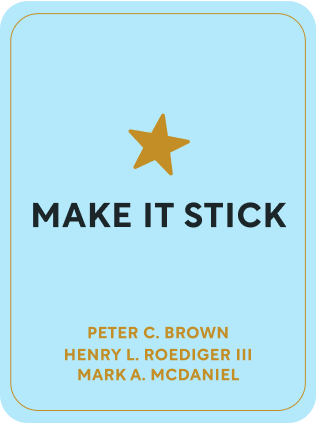

This article is an excerpt from the Shortform book guide to "Make It Stick" by Peter C. Brown, Henry L. Roediger III, Mark A. McDaniel. Shortform has the world's best summaries and analyses of books you should be reading.
Like this article? Sign up for a free trial here .
What is the book Make It Stick about? How can applying the book’s lessons help become more effective at learning?
In their book Make It Stick, co-authors Henry L. Roediger III, Mark A. McDaniel, and Peter C. Brown teach you the strategies that help you achieve the two primary goals of learning: to understand and remember what you learn so you can use your knowledge in future situations. Drawing from a vast number of research studies, they discuss the most effective learning strategies and caution against learning techniques that turn out to be counterproductive.
Read all about the key concepts in the book Make It Stick: The Science of Successful Learning.
Make It Stick: The Science of Successful Learning
In their book Make It Stick, Henry L. Roediger III, Mark A. McDaniel, and Peter C. Brown teach you how to learn and study based on data about how your brain comprehends and retains information.
The book’s principles and prescriptions draw from a vast number of research studies. Two of the authors, cognitive scientists Henry Roediger and Mark McDaniel, collaborated with other researchers on a 10-year study about how to apply cognitive psychology to improve learning practices, and a number of their findings are included in the book.
If you want to improve your learning, you must first define your goals for learning and studying. This book doesn’t help you simply pass the midterm—it teaches you how to absorb and master new information.
The two main goals of learning a new skill or concept are:
- Comprehension: You want to gain a deep understanding of the underlying principle in order to understand how it applies to different situations.
- Retention: You need to remember the information when a problem or situation calls for it, and when you get a chance to build upon it with more advanced knowledge.
Improve Comprehension Through Structure Building
When you’re learning something new, instead of simply memorizing the information from your textbook or lecture notes, you’ll gain a more meaningful understanding if you identify the rules, which are the underlying principles that will guide you when you call on this knowledge to solve real-world problems. In order to extract the main principles, you need to be able to weed out extraneous information.
Strategies to identify rules include:
1) Examining multiple examples at once—instead of one at a time—in order to more clearly see the common thread and extract the underlying principles.
- For instance, if you want to learn more about butterflies, instead of examing species one at a time, study a variety of butterfly species at once and note their similarities and differences.
2) Examining two different problems at once, in hopes of finding similarities or differences that illuminate the rules and help you reach each problem’s solution.
- For instance, when solving two unrelated problems, such as 1) how to get a large group of firefighters across a river without breaking its fragile bridges and 2) how to treat a tumor without damaging the healthy tissue surrounding it, compare the problems. The similarities (a high volume of something needs to reach a target, but sending it all at once will cause damage) might lead to solutions (direct smaller forces at the target through different passages—multiple bridges or different angles of radiation—at the same time).
Once you recognize the rules, connect those principles with prior relevant knowledge. This process—called structure building—creates context, which deepens your understanding.
Structures help you create mental models, which bring together interrelated concepts or skills into one fluid skillset. For example, driving a car requires knowledge of traffic laws as well as motor skills to push the brake pedal and turn the wheel with the right amount of force. At first, it feels like you’re juggling several skills at once, but experience merges them all into a mental model that enables you to drive without consciously thinking about each individual action.
Mental models are essential for achieving mastery—such as the driver who appears to react instantaneously when another car abruptly cuts into her lane or suddenly brakes right in front of her. The more mental models you have, the better prepared you are to navigate any situation. Additionally, practicing your mental models in a variety of contexts improves your ability to apply them in different situations. For example, if you’re skilled at driving a car in various road, weather, and environmental conditions, you’ll be better able to apply those skills to driving a bus or an RV.
Improve Retention Through Retrieval Practice
Knowing a skill is one thing—but remembering it when a situation calls for it is what counts. And the better you remember something, the more reflexively you can recall that information when you need it.
Many people try to burn information into their memories by rereading, but this approach only commits the information to their short-term memories, making it a waste of time in the long run. Instead, the most effective way to improve retention of new information is through retrieval practice, which is any exercise that requires you to recall what you’ve learned. You can practice retrieval with classroom quizzes, flashcards, self-testing, and reflection, when you assess how you approached a particular problem and how you can improve next time.
Follow three principles to maximize the benefits of your retrieval practice:
1) More difficult retrieval leads to better retention. The harder your brain has to work to retrieve the information, the more firmly it cements it in your memory.
One way to create this “desirable difficulty” is by using generation, which requires you to generate the answer from memory (for example, using flashcards or short-answer questions instead of multiple-choice questions). Another way is to delay your retrieval practice long enough that your memory has gotten a little fuzzy and your brain has to work harder to retrieve the information.
2) Frequent testing improves retention. Regular testing deepens your comprehension, which improves your ability to apply the knowledge in different contexts. And the longer you continue regular testing—even after you feel that you’ve mastered the skill—the longer-lasting your retention will be.
The most effective testing schedule is to build in a slight delay before the first test, and then follow up with regular testing at various intervals.
3) Corrective feedback is crucial to prevent students from remembering the wrong answer, and to reinforce the correct information.
Corrective feedback is most effective when it’s slightly delayed, because immediate feedback can become a crutch in learning and mastering the material. Immediate feedback is like learning to ride a bike with training wheels—the correction is so automatic that you begin to rely on that support, which inhibits you from truly learning and mastering the skill.
Spaced Practice
As we mentioned, spacing out your retrieval practice creates desirable difficulties that improve your retention. Instead of focusing on one skill or topic at a time—a strategy called massed practice—spaced practice gives your brain the time it needs to strengthen new knowledge and store it in your long-term memory through a process called consolidation.
There are two strategies that naturally space your practice:
1) Interleaved practice mixes your practice among multiple related topics or skills. For example, if you’re learning how to calculate volumes of different geometric shapes, mix up the problems—doing a sphere problem, then a cube problem, then another sphere problem—instead of grouping your practice problems by shape. Not only does interleaving space your practice, but it also helps you make mental connections to the other subjects you mix in.
The key to interleaving is to switch to the next skill or concept before you’ve finished practicing one. It feels frustrating to switch gears before you’re ready, but this method improves your long-term retention.
2) Varied practice involves practicing a skill in different contexts. This strategy strengthens your understanding of the underlying principles and your ability to apply that skill in a variety of situations, as in the example of improving your driving skills by practicing in various weather conditions.
Inaccurate Self-Assessment Inhibits Learning
In order to expand your learning, you need to know what you know, what you don’t know, and what you need to work on. But people are poor judges of their own knowledge and abilities, and those miscalculations can inhibit learning.
There are several reasons humans struggle to accurately gauge their own competencies:
- Perceptual illusions distort your senses and make you misinterpret images, sounds, or other sensations. For example, pilots can encounter optical illusions or, in extreme situations, illusions that make them think the plane is flying level when it’s actually tilted.
- Cognitive biases are caused by systematic problems with your way of thinking that impact your judgment and decision making. For example, the bandwagon effect is a cognitive bias that makes people more likely to think or do something if other people think or do it.
- A “hunger for narrative”—the natural desire to create narratives that explain why things are the way they are—leads people to misinterpret situations. Narratives are a stronger influence than objective facts, yet people fail to recognize or vastly underestimate this influence. For example, if your parents made a lot of money from running their own business, you may extoll the concept of pulling yourself up by your bootstraps and climbing the socioeconomic ladder, and you may have a hard time understanding anyone’s argument for social welfare programs.
- Distorted memories lead people to color their memories with false details, and even claim to remember something that never happened. The human memory is inherently moldable, lending itself to distortions and false memories. For example, if a witness to a crime views photos of suspects and then subsequently looks at a lineup, she’s more likely to falsely accuse someone in the lineup if she’s already seen his photo.
- Misdiagnosing a problem and failing to recognize that it requires a different approach than what your mental model dictates. For example, brain surgeons typically have to perform surgery slowly and steadily, but if certain conditions create pressure in the brain, their patients’ lives depend on them doing the opposite and working as quickly as possible.
- Oblivious incompetence makes people overestimate their own abilities and underestimate their need to improve.
When these factors impede your ability to accurately gauge your knowledge and ability, you don’t know where your gaps in knowledge are. You’re less likely to spend the extra time practicing the things you need to work on, and when a real-life situation calls for that knowledge, you fall flat.
However, you can improve your gauge of your own competence. Use these learning strategies to help you keep an accurate view:
- Apprenticeship: Learning alongside a seasoned veteran gives you a clearer view of your skill level compared to an expert’s.
- Peer Instruction: Collaborative learning with your peers helps you to avoid the kinds of misconceptions you can have when you study by yourself.
- Peer Review: Your fellow students or professionals can tell if you’re doing a good job or not, and if they give you honest feedback, you can adjust and improve as needed.
- Team Learning: When you work in a team of people who have complementary skills, each member of the team has an opportunity to learn from the others. Additionally, each person’s strengths are on display, and it’s often apparent if someone is falling short.
- Real-World Simulations: Training under conditions that resemble what you will face in real-life situations is the best way to hone your skills and see any gaps between conceptual learning and application.
Don’t Let Learning Styles Limit You
Aside from illusions that alter your perception of your knowledge, your learning can also be impeded by myths about your ability to learn. There’s a common belief that everyone has a learning style—such as auditory, kinesthetic, or visual—and that individuals learn best when the style of instruction matches their learning style.
There are two problems with this belief:
- While it may be true that people have distinct preferences about the way they learn, research shows that learning isn’t inhibited if the style of teaching doesn’t match the learning style. In fact, everyone learns best when the style of instruction matches the subject of the lesson, such as using visual means to teach geometry, audio to teach foreign language, or kinesthetic to teach physics principles on motion.
- A focus on learning styles tends to limit a student’s views of her own abilities and potential. That limitation can affect the student’s confidence to try new things, how much effort she puts forth, and her perseverance in the face of obstacles.
Intelligence Isn’t Fixed
In addition to the myth of learning styles, the myth that intelligence is fixed also impedes people’s learning. When people believe they’re born with a predetermined capacity for learning, they don’t put as much effort into learning. However, intelligence isn’t fixed.
In fact, Americans’ average IQ has risen over time. Several factors affect IQ scores, including a person’s genes, environment, socioeconomic status, and nutrition.
Make the Most of Your Intelligence
You don’t have to raise your IQ score to maximize your intelligence.
Here are three strategies for raising your abilities:
1) Have a growth mindset. People with growth mindsets understand that effort and discipline are critical to learning, so they work harder, take more risks, and view failures as learning opportunities. By contrast, people with fixed mindsets believe intelligence is fixed and that it determines success, so they become helpless in the face of failure because they attribute it to their lack of innate ability.
2) Perform deliberate practice. Deliberate practice is crucial to reaching mastery, and it’s distinct from mere repetition because it’s solitary, it’s goal-oriented, and it consistently pushes you past your current ability. Pushing yourself, failing, troubleshooting, and trying again are necessary to create mental models and achieve mastery.
3) Use memory cues. Memory cues help you organize and retain information using familiar triggers. Memory cues include mnemonic devices like acronyms or more complex tools like memory palaces.
Put These Strategies Into Practice
Now that you understand the principles of effective learning, here are some tips for applying them.
Students and learners, take an active approach to your learning:
- Pause regularly to ask yourself questions about the key concepts in the material you’re learning.
- Think of a metaphor or image that demonstrates the principle you’re learning.
- Try to define concepts before finding the definition, and try to solve math and science problems before learning the formula.
- As you study, create questions to quiz yourself later.
- Regularly quiz yourself on new and past material, interleaving multiple subjects. Study the topics of the questions you get wrong.
Teachers, teach your students about the principles and strategies of effective learning—the importance of desirable difficulties, failure, and pushing beyond current ability. Incorporate them into your curriculum by:
- Using the principles of spacing, interleaving, and variation in your lesson planning.
- Giving frequent, low-stakes quizzes that incorporate past material.
- Providing study aids that use retrieval practice, elaboration, and generation—such as practice tests and short-answer exercises.
- Asking students to spend 10 minutes at the end of class writing about everything they remember from the day’s lessons. After the 10 minutes, they should revisit their notes to find out what they’ve forgotten, and then study that information.
- Putting students into small groups to collaborate on high-level conceptual questions posed by the teacher, or on concepts they’re struggling with in the material.

———End of Preview———
Like what you just read? Read the rest of the world's best book summary and analysis of Peter C. Brown, Henry L. Roediger III, Mark A. McDaniel's "Make It Stick" at Shortform .
Here's what you'll find in our full Make It Stick summary :
- How to understand and remember what you learn
- How a little forgetting helps you remember
- Why you’re not a good judge of how much you know






